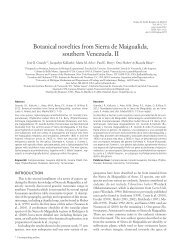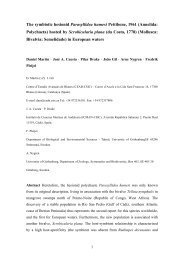PhD Thesis MJProl .pdf - digital-csic Digital CSIC - Consejo Superior ...
PhD Thesis MJProl .pdf - digital-csic Digital CSIC - Consejo Superior ...
PhD Thesis MJProl .pdf - digital-csic Digital CSIC - Consejo Superior ...
Create successful ePaper yourself
Turn your PDF publications into a flip-book with our unique Google optimized e-Paper software.
New strategies for the control of bacterial infections in marine fish larval rearing 5<br />
After mouth opening and the onset of exogenous feeding, it is relatively easy to<br />
manipulate the bacterial diversity in the gut by the use of bacteria bioencapsulated in<br />
prey as rotifers or Artemia metanauplii (Makridis et al., 2000a). This phase is critical in<br />
many aspects for the successful rearing of marine fish larvae as pioneer species, i.e.<br />
bacterial populations that firstly colonize the gut, have a competitive advantage<br />
compared with bacteria that reach the gut at a later stage, when available adhesion sites<br />
have been reduced and environmental conditions are influenced by the bacterial<br />
populations already established (Hansen and Olafsen, 1999; Skjermo and Vadstein,<br />
1999).<br />
A main characteristic of the type of colonization in the gut of larvae is that species<br />
established during this period are mainly opportunistic, taking advantage of the input of<br />
nutrients in a “new” environment (larval gut). The establishment of excessive numbers<br />
of bacteria in weakened larvae may result in high mortalities, but mortalities in healthy<br />
larvae, not exposed to environmental stress and fed on high quality prey, are low and<br />
not dependent on the numbers of bacteria present in the gut (Makridis et al., 2008;<br />
Salvesen et al., 1999).<br />
At the stage of weaning, the numbers of bacteria decrease and relatively few<br />
bacteria are measured in the fish gut per unit of gut weight compared with the earlier<br />
stages (Makridis et al., 2008). The development of stomach and its acid barrier makes<br />
more complicated the direct influence of species established in the intestinal microbiota<br />
by addition of probiotics in the feed.<br />
1.2. New strategies for bacterial infections control in fish larvae<br />
The development of new strategies is based mostly on the study and knowledge of<br />
microbial diversity and ecology in marine fish larviculture systems (Figure 1.1).<br />
Strategies can be classified as based on:<br />
i) Acting and modifying the microbiological communities of the system,<br />
including or not the introduction of live microorganisms.<br />
ii) Acting on host-microbe interactions, which include the use of<br />
immunostimulants.

















